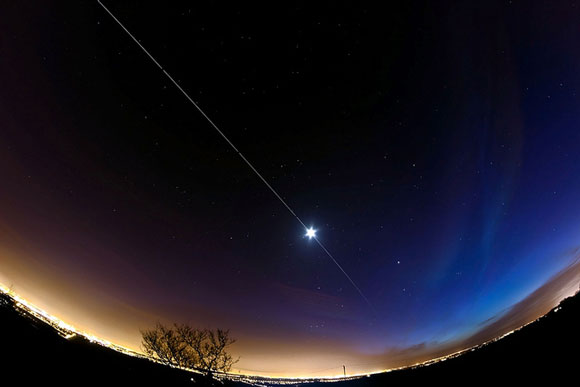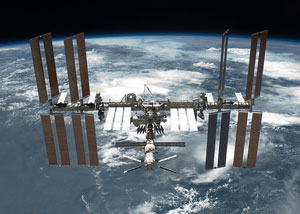Is it a meteor? Is it a plane? It might be the International Space Station (ISS).
Every so often, the ISS becomes visible in the night sky. To us on Earth, it looks like a bright star moving quickly above the horizon. The ISS is so bright, it can even been seen from the center of a city. Then, just as suddenly as it appeared, it disappears. How do you know when you can see the ISS in your night sky?

A composite photograph of the International Space Station taken from Earth. Image Credit: Dave Walker.
NASA has started a Spot the Station program where people from around the world can sign up to receive alerts when the ISS will be visible from your location. You can receive alerts via email or a text message to your phone. Typically, alerts are sent out a few times each month when the station’s orbit is near your location. Visit the Spot the Station website here to sign up, and view a list of upcoming sighting opportunities.
Notices will only be sent to you when the ISS will be clearly visible from your location for at least a couple of minutes. If you live north of 51.6 degrees latitude (for example, in Alaska), you will likely have to visit the website to find sighting opportunities because notifications in this region would be rare.
The notices contain information on where to look for the ISS in the night sky. Just note where the sun sets and you can easily find the direction where the station will appear (for example, in the southwest or in the northwest). The height at which the station will appear is given in degrees. Just remember that 90 degrees is directly over your head. Any number less than 90 degrees will mean that the station will appear somewhere between the horizon and the 90 degree mark. The station is so bright that it is really hard to miss if you’re looking in the correct direction. Alternatively, you can stretch out your fist at arm’s length toward the horizon, which is equivalent to about 10 degrees. Then, just use the appropriate number of fist-lengths to find the location marker, e.g., four fist-lengths from the horizon would be equivalent to about 40 degrees.

Photograph of the International Space Station taken from the space shuttle Endeavour on May 30, 2011. Image Credit: NASA.
So far, more than half a million people have signed up to receive alerts from NASA’s Spot the Station program. I’ve seen the station fly over twice now and it’s a pretty amazing experience—gets you thinking about how far our technology has advanced.
The first module of the ISS was launched into space in 1998 and the initial construction of the station took about two years to complete. Human occupation of the station began on November 2, 2000. Since that time, the ISS has been continuously occupied and over 214 people have visited to date. The ISS serves as both an orbiting laboratory and a port for international spacecraft. The primary partnering countries involved in operating the ISS include the United States, Canada, Europe, Japan and Russia.

Astronauts Robert Curbeam, Jr. and Christer Fuglesang working on the International Space Station. Image Credit: NASA.
The ISS orbits at approximately 220 miles above the Earth and it travels at an average speed of 27,724 kilometers (17,227 miles) per hour. The ISS makes multiple orbits around the Earth every day. So far, the ISS has traveled more than 1.5 billion miles through space.
Bottom line: Check out the ISS in the night sky the next time it flies over your location. You can sign up to receive alerts with NASA’s Spot the Station program or visit that website to view a list of viewing opportunities.

You need to be an initiate of Sky Watch to add comments!